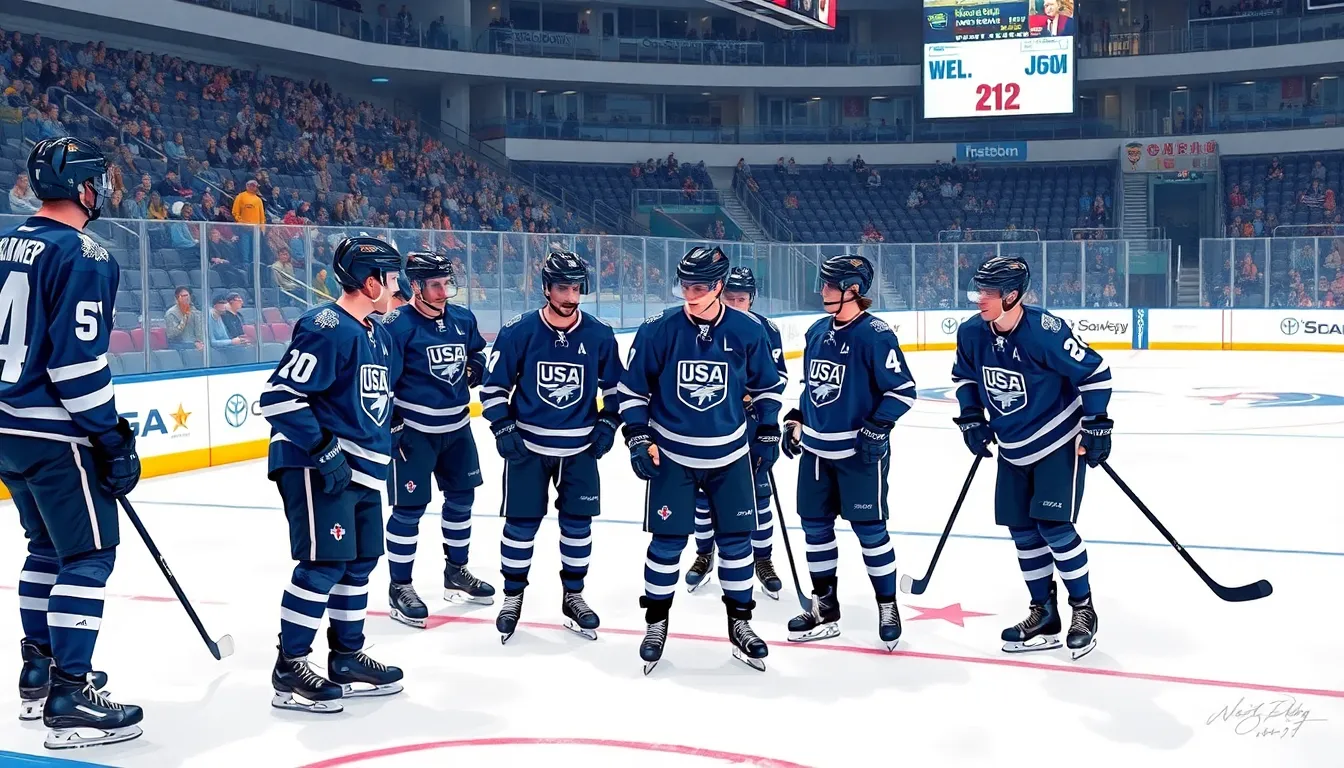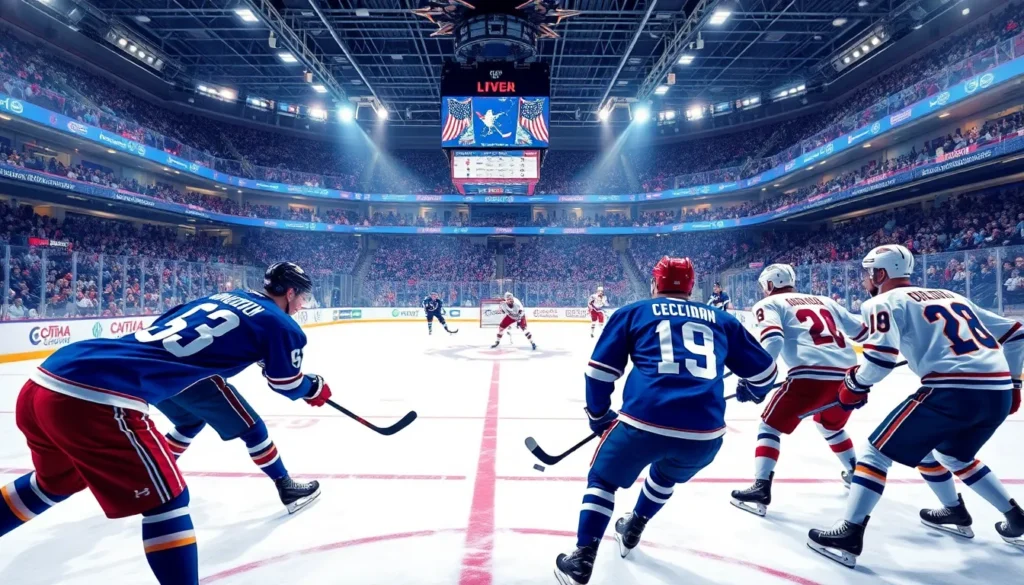Table of Contents
ToggleWhen it comes to hockey, understanding the game’s structure can be as tricky as a slapshot from the blue line. One of the burning questions fans often ask is, “How long is a period in hockey?” Whether you’re a die-hard fan or a newbie trying to impress your friends, knowing the ins and outs of game time can make all the difference in your viewing experience.
Each period is packed with excitement, speed, and enough adrenaline to fuel a rocket. But just how long do players get to showcase their skills before the zamboni swoops in? Spoiler alert: it’s not as short as a coffee break but not quite as long as a Netflix binge. Let’s dive into the nitty-gritty of hockey periods and help you become the smartest fan in the room.
Understanding The Duration Of Hockey Periods
Hockey periods last 20 minutes in professional leagues like the NHL and international competitions. Game flow remains consistent, with a standard three-period structure. Each period is crucial for strategies and team performance.
Breaks occur between periods, lasting approximately 15 minutes. These intermissions provide teams an opportunity to regroup and adjust tactics. During stoppages, players rest while coaches make adjustments.
Overtime rules differ depending on league regulations. In the NHL, if a game is tied after three periods, a 5-minute overtime period follows. This session is played with three skaters and one goalie per team, adding excitement to the match. If the score remains tied, a shootout occurs, determining the winner.
College hockey features slightly different timings. NCAA rules assign 20-minute periods as well, but can include sudden-death overtime in playoffs. During playoffs, each overtime session lasts 20 minutes, continuing until a goal is scored. This format raises the intensity of the game.
Understanding the duration of periods enhances the viewing experience. Fans grasp the rhythm and pace of the game, appreciating strategies and team adjustments. By knowing the time structure, they can better anticipate shifts in action and potential outcomes.
Standard Duration In Professional Hockey

Periods in professional hockey last 20 minutes. This standard duration applies across major leagues, including the NHL and international competitions.
NHL Regulations
In the NHL, each game consists of three periods. Players aim to score within these 20-minute increments while adhering to specific regulations. Following each period, there’s a 15-minute intermission. Adjustments can occur during this break as teams strategize for the next segment. If a game is tied after regulation, a 5-minute overtime ensues. This overtime, played at three skaters and one goalie per team, adds intensity. A shootout determines the winner if the score remains tied after overtime.
International Play Standards
International hockey upholds the 20-minute period structure as well. Each match typically features three periods, just like the NHL. Subsequently, a 15-minute break allows teams to regroup. During playoff rounds, sudden-death overtime can elevate the stakes further. Under international guidelines, matches that end in a tie proceed directly to a shootout. These similarities and differences across leagues influence how fans perceive the game’s excitement and flow.
Factors Influencing Period Length
Various elements shape the length of hockey periods. These components contribute to the overall flow and excitement of the game.
Overtime Rules
NHL rules stipulate a 5-minute overtime for tied games, featuring three skaters and one goalie per team. If the score remains tied after this period, a shootout occurs to decide the winner. Each team alternates attempts in the shootout, with the first team to score winning the match. This format ensures that a definitive conclusion arises from the contest without extending gameplay excessively.
Special Game Formats
Certain tournaments, such as international competitions, employ distinct formats that influence period length. For instance, some leagues may incorporate 3-on-3 overtime to enhance scoring opportunities. Additionally, playoff scenarios often feature extended sudden-death rules, where the first team to score wins, resulting in more thrilling and unpredictable finishes. These variations foster excitement and maintain fan engagement while setting unique expectations for the duration of each contest.
The Importance Of Period Length
Period length in hockey significantly affects various aspects of the game. From strategy to viewer experience, understanding these elements enhances appreciation for the sport.
Impact On Game Strategy
Game strategy hinges on period length. Coaches often adjust tactics based on time remaining. A 20-minute period allows teams to implement multiple plays and adjustments, affecting defense, offense, and player rotations. Players must manage energy levels effectively throughout each period. The necessity for stamina and strategic positioning becomes crucial as the clock ticks down. Late period situations may lead to aggressive plays or conservative defenses, influencing the game’s outcome. Overall, the defined period length shapes strategies, impacting team performance and decisions.
Viewer Experience
Viewer experience correlates strongly with period length. Each 20-minute segment creates defined phases of intense action and suspense. This structure allows fans to become engaged, offering ample opportunities for scoring and momentum shifts. Intermissions provide breaks for viewers, enhancing anticipation for the next period. While regular gameplay maintains excitement, overtime creates heightened tension. Spectators often appreciate the blend of structured periods and unexpected outcomes, making every game unique. The combination of standard periods with possible overtime ensures a thrilling experience, captivating current and potential fans alike.
Understanding the duration of hockey periods enriches the viewing experience. Each 20-minute period creates a framework for strategy and excitement that keeps fans on the edge of their seats. The structured format allows coaches to adapt their game plans while players manage their stamina effectively.
The potential for overtime and shootouts adds an extra layer of thrill to the game. This combination of regulation play and sudden-death scenarios ensures that every moment counts. As fans engage with the sport, they’ll appreciate how period length impacts not just gameplay but also the overall atmosphere of the match. With this knowledge, they can enjoy hockey even more, whether they’re watching a regular season game or a nail-biting playoff showdown.







